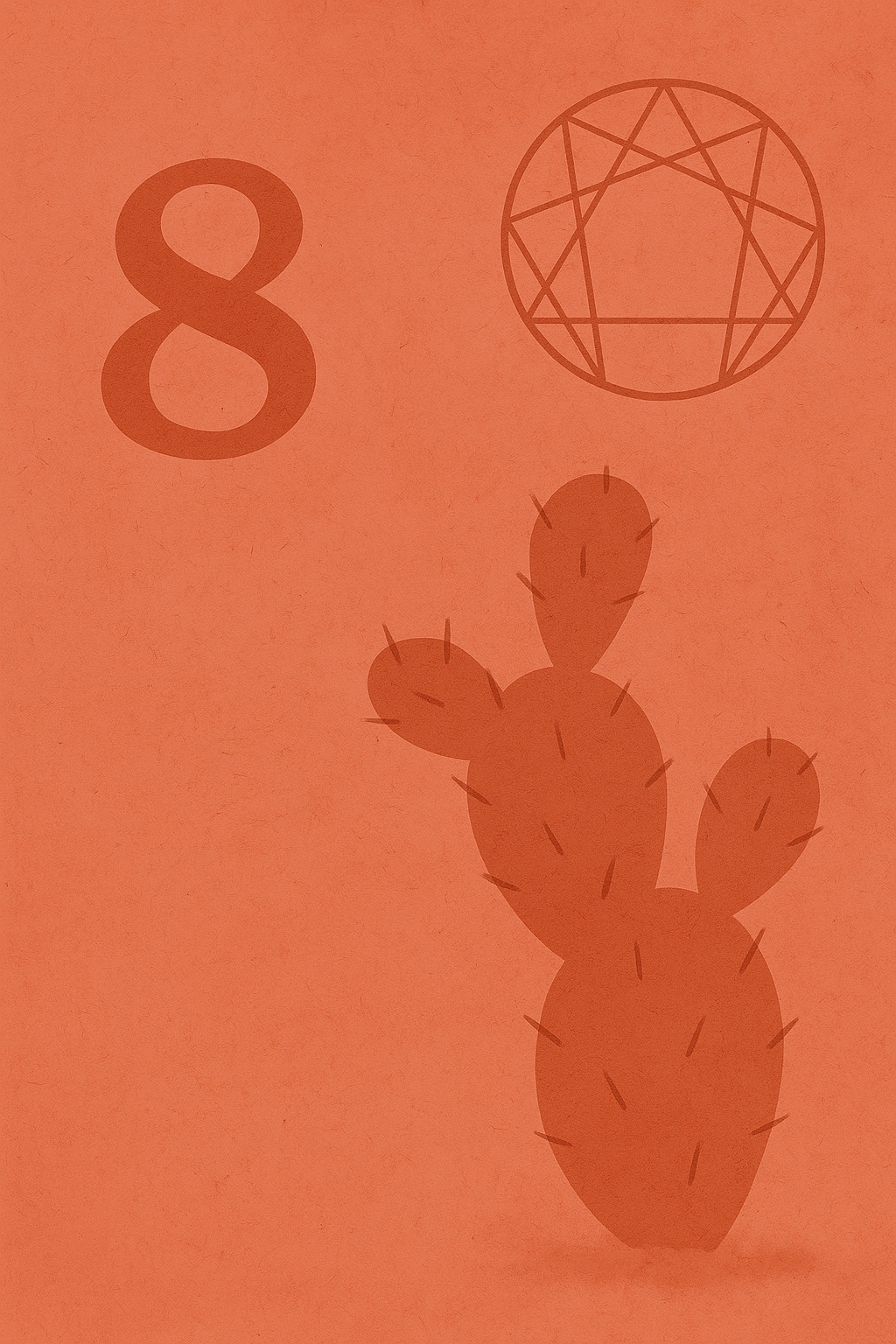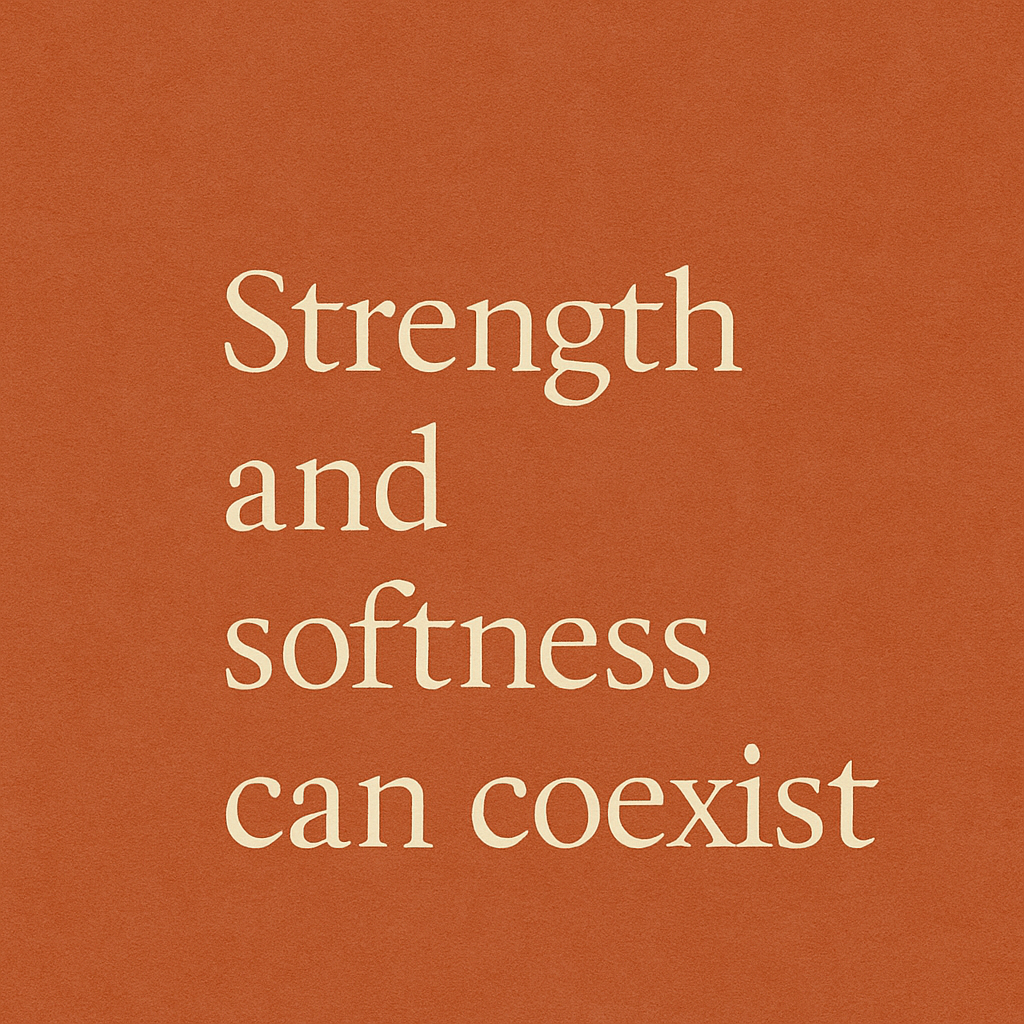Introduction
Type Eights are the storm and the shelter. They walk into a room with presence and power, often commanding attention without saying a word. These are the people who get things done, who defend the underdog, dismantle weak systems, and pull others into their sphere of protection. They might come across as intense or intimidating, but at their core, Eights are deeply tender, fiercely loving, and determined not to be betrayed or controlled.
Beneath the armor is a longing: to feel safe in vulnerability, to rest in trust. But for many Eights, early experiences taught them that vulnerability equals danger. So instead, they arm themselves with strength, intensity, and autonomy.
Over the years, I’ve heard people describe “unhealthy Eights,” but what they often mean is: someone showed up in power, and they didn’t know what to do with it. Eights are blunt, fast-moving, and commanding. They have no patience for passive-aggression, and they’re rarely interested in sugarcoating the truth. That kind of energy can rattle people, especially those who aren’t used to directness or intensity. But that doesn’t necessarily make the Eight unhealthy. It might just mean they were the only one willing to say the thing out loud.
Eights don’t tend to offer themselves up freely. If you ask them how they are, they might respond with, “Ask me anything,” as if to say: I’ll answer, but I’m not giving anything away unless you’re bold enough to ask. They often overshare certain things early, almost like a test: Can you handle this? Are you going to bail? It’s a defense strategy rooted in their core fear of betrayal.
They’re also exceptional in a crisis, not because they’ve run through every scenario like a Type Six might, but because they trust themselves to handle whatever comes. They’re wired for action. They know they can rise to the occasion, take control, and do what others can’t or won’t.
At their best, Eights are protectors, advocates, and truth-tellers. They are fierce and full of fire, but that fire is meant to light the way, not burn it down.
1. Center Of Intelligence: The Gut (Types 8, 9, 1) = Anger
[The Enneagram divides the nine types into three Centers of Intelligence: the Head, Heart, and Gut. Each center processes the world primarily through either thinking, feeling, or instinct.]
Types in the Gut Triad tend to process the world through instinct and body-based knowing. They take in the world through their body, sensing right and wrong, pressure, resistance, and alignment on a gut level. Their internal radar often leads with “this feels right” or “this feels off,” even before they can explain it.
The emotional struggle that colors this center is anger — sometimes direct and explosive (like 8s), sometimes internalized (like 1s), or numbed out entirely (like 9s). Learning to notice, express, and work with anger in healthy ways is a major growth path for Gut types.
If you’re a Type 8, 9, or 1, you likely value independence, have strong gut reactions, and wrestle with how to assert yourself in a world that often feels demanding or out of sync with your internal compass.
2. Core Motivation, Fear, and Desire
[These are the inner drivers behind the type’s behavior: the deep needs they’re trying to meet, the fears they avoid, and what they long for most.]
Key Motivation: To be self-reliant, prove strength, resist weakness, stay in control, and protect themselves and others.
Basic Fear: Being controlled, harmed, or violated.
Basic Desire: To protect themselves and others, to be in control of their life and destiny.
3. Wings
[Your “wings” are the two numbers on either side of your core type. Most people lean more toward one or the other, which flavors their personality.]
7 Wing – (The Maverick): Brash, energetic, and fast-moving. These Eights have a spark of Sevens’ enthusiasm and spontaneity, making them bold adventurers with a quick wit and a flair for risk. Think: trailblazer with a jetpack.
9 Wing – (The Bear): More grounded and calm than the 8w7, this subtype brings the solid, steady energy of Nines. Think: immovable mountain with a soft heart. They lead with quiet strength and can be surprisingly diplomatic.
4. Relational Stance
[Each Enneagram type belongs to one of three stances: strategies for how we move through the world and try to get our needs met. These stances describe habitual energy patterns, not just how you interact with others, but how you cope with stress, seek connection, and protect your sense of self.]
Stance: Aggressive (Assertive) Moves against others to assert control and avoid vulnerability. Eights prefer to lead rather than follow and often push into life rather than wait to be invited.
Repressed Center: Productive Feeling
Eights have access to emotion, but they often suppress softer feelings like sadness, tenderness, or fear. They’re more comfortable with anger, justice, and determination.
5. Passion (Sin): Lust
[This is the emotional habit or "core vice" of the type, the thing they fall into when they’re out of alignment with their true self.]
Not necessarily sexual (though it can be) but a lust for life, power, intensity, and big impact. Eights don’t do things halfway. It’s all or nothing.
Lust means: a desire for aliveness, force, and influence. To live fully, and on their terms.
6. Childhood Patterns
[This section highlights the unconscious messages each type internalized in childhood, both the false beliefs they absorbed and the healing truths they missed but longed to hear.]
Unconscious Childhood Message: “It’s not okay to be vulnerable or trust anyone.”
Lost Childhood Message: “You will not be betrayed.”
For many Type Eights, childhood was a place where power dynamics were front and center. Whether through neglect, betrayal, control, or loss, Eights often internalized the belief that the world is unsafe and people can't be trusted. So they stepped up. They became their own protector: strong, independent, and armored.
Instead of learning it was okay to be soft or ask for help, they were praised (or forced) to be tough. Vulnerability became a liability. Emotions like fear or sadness were often hidden behind a wall of intensity or anger. Some Eights were parentified early, taking on adult responsibilities to survive or to shield others.
This doesn't necessarily mean Eights had a “bad” childhood. But it often means they grew up fast. They learned early that being in control felt safer than depending on anyone else. At the core, their protective instinct is rooted in a deep desire to never be hurt or betrayed again.
7. Growth and Stress Arrows
In Growth (toward Type 2): Becomes more open-hearted, nurturing, and compassionate. Learns to use their strength to connect, not just protect.
In Stress (toward Type 5): May withdraw, become secretive, emotionally detached, and suspicious. Eights in stress can isolate or become hyper-independent.
[The Enneagram symbol includes dynamic lines that show where each type tends to go under stress and where they go when growing. When stressed, a type may take on the less healthy traits of another number. In growth, they may adopt the healthier aspects of yet another. Understanding these arrows helps with intentional development.]
8. Superpower
[Every Enneagram type brings a specific gift to the world, a unique strength that flows when they’re aligned and healthy. This isn’t just what they’re good at, it’s what makes them a necessary part of a thriving, balanced world.]
Embodied Strength. Intensity.
Eights have the ability to lead, protect, and advocate in ways that shake the room. Their presence is power, and when healthy, they offer fierce loyalty and unmatched courage.
9. Common Challenges
[This section explores what tends to trip this type up: recurring emotional patterns, blind spots, and areas of struggle. These aren’t flaws, but rather predictable pitfalls that can become opportunities for growth with awareness and support.]
Avoiding vulnerability or softness
Struggling to express tender emotions (fear, sadness, hurt)
Confrontational communication, especially when boundaries are crossed
Trust issues, especially if betrayal is perceived
Impatience with indecision or inaction, Eights move fast and with conviction, so when others hesitate, overthink, or avoid conflict, it can feel maddening or weak to them
Pushing people away to test loyalty, some Eights overshare bold or abrasive truths early as a way of weeding out anyone who can’t handle their intensity
Assuming they have to do everything alone because they fear being let down, many Eights would rather take control than risk trusting others to follow through
10. Subtypes
[This refers to your dominant instinct, self-preservation, social, or one-to-one (also called sexual), which shapes how your Enneagram type shows up in daily life. Each type can look quite different from each other. Each Enneagram type has an instinctual subtype that is often called the “countertype.” This version runs counter to the usual stereotype of the type, meaning it may express its core motivation in a less obvious or even contradictory way. Countertypes can make it harder to spot your number at first because they don’t always “look like” the textbook version, but the underlying motivation is still the same.]
Self-Preservation (Survival Boss): Looks more controlled and practical. May be less obviously aggressive but still deeply protective. Focused on security and physical autonomy.
Social (Group Defender): More openly aggressive and intense. Will challenge the powerful and protect the weak. Think: justice warrior.
(Countertype)
One-to-One (Possessive Rebel): Deeply passionate and magnetic. Can be dominating or overwhelming in close relationships. Fiercely loyal, but also expects loyalty in return.
11. Emotional, Energy, and Communication Style
[This section explores what tends to trip this type up: recurring emotional patterns, blind spots, and areas of struggle. These aren’t flaws, but rather predictable pitfalls that can become opportunities for growth with awareness and support.]
Emotional Style:
Stoic, intense, and deeply sincere. Eights often keep their more tender emotions close to the chest, showing strength instead of vulnerability. They may seem curt or armored, but underneath, they feel deeply and love fiercely.
Energy:
Big, bold, protective. Type Eights carry a powerful presence, often filling a room just by being in it. Their energy is clear and direct, rarely muddled or passive. It can feel electric, driven, or commanding.
Communication Style:
Direct, assertive, honest. Eights say what they mean and expect others to do the same. They value truth over niceness and can come off as confrontational, blunt, or even harsh, especially when they feel disrespected or protective of others. But underneath, there's often a desire to connect through honesty and strength.
12. Therapy Perspective
[Practical notes from a therapist’s point of view. What this type might need in counseling and what healing often looks like. This is where you’ll find tips, reminders, and patterns that tend to emerge when this type is doing inner work.]
In therapy, Eights benefit from spaces that feel safe, empowering, and non-controlling. Therapists should earn their respect by being direct and authentic, not overly placating. Eights need to choose vulnerability, not be forced into it.
They often respond best to work that helps them explore trust, grief, and emotional expression, especially sadness and fear. Helping them soften without feeling weak is a key part of the journey.
I like to specifically ask my Eights what they want to talk about. I find that in therapy they tend to let the therapist take the lead, but having talked to Eights that have been in therapy before, many have felt like the therapist led too much with stuff they weren’t there to deal with and would often leave feeling like all they did was “bitch”. So, from that, my takeaway has been to ask what they want to deal with that day, and it has resulted in much more productive sessions.
The most common occurrence of having Eights in the therapy room (in my professional experience) is when their partner brings them for couples therapy. And I will say, although female 8s are not as common, I see far more of them than male 8s.
13. Pop Culture Examples (Hypothetical)
[Real and fictional people who are widely considered to represent this Enneagram type. These examples help ground abstract concepts in relatable characters and show how the type can manifest in very different lives.]










Real People:
Serena Williams
Fierce, dominant, and unapologetically powerful. Serena embodies the physical presence, boldness, and boundary-setting of a strong Eight.Martin Luther King Jr.
While sometimes typed as a 1, many recognize his unwavering courage, resistance to oppression, and protective drive for justice as deeply Eight-like traits, especially in health and growth.Donald Trump (a more controversial but widely accepted example)
Often cited as an Eight due to his larger-than-life presence, confrontational style, and need for control. He represents the more defensive, dominance-driven side of the spectrum. Whether admired or criticized, his Eight energy is undeniable.Gordon Ramsay
Blunt, intense, and fiercely loyal to those he believes in. His no-nonsense leadership style and protective mentoring reflect classic Eight dynamics.Rihanna
Unapologetically herself, confident, and boundary-driven. Rihanna challenges systems, commands her empire, and protects her autonomy, hallmarks of a healthy, self-possessed Eight.
Fictional Characters:
Moana (Moana)
Driven by instinct and a deep longing for something more, Moana refuses to stay small. Her boldness, independence, and refusal to be controlled all speak to the Eight’s core. She leads fiercely but with heart and her "lust for life" is what ultimately restores balance.Rip Wheeler (Yellowstone)
Emotionally armored, intensely loyal, and always ready to defend what's his. Rip is the classic strong-but-tender Eight: willing to do the dirty work to protect his people, but deeply loving once you’re in his circle. He lives by a code and woe to anyone who crosses it.Wolverine / Logan (X-Men)
The gruff, emotionally walled-off protector. Wolverine uses his strength and aggression to keep people at arm’s length, but he’s deeply loyal and soft underneath, especially with those he allows close.Princess Leia Organa (Star Wars)
Leia combines intelligence with fierce protectiveness and unwavering leadership. She doesn’t back down from conflict and speaks truth to power, all while carrying the emotional weight of loss with grace and resolve.Rosa Diaz (Brooklyn Nine-Nine)
Cool, deadpan, and unapologetically blunt. Rosa keeps her feelings locked down but is incredibly loyal. Her intensity and independence are classic Eight traits, and when she lets you in, you’re in for life.
Path to Growth: So, Now What?
What Growth Means for Type 8
For Eights, growth is about balancing strength with vulnerability. It means learning that being powerful doesn’t require suppressing weakness; that protecting others doesn’t have to come at the cost of closeness; and that authenticity involves opening up, letting one’s heart and softness show, not just power and control. Growth is moving from always needing to appear in control, strong, and invulnerable towards receptivity, courage, and strength expressed with empathy for others.
Early Signs of Growth
Recognizing one’s impulses toward control, dominance, or protecting oneself by pushing others away and catching them before acting.
Allowing moments of vulnerability: admitting a fear, showing uncertainty, expressing dependency or hurt.
Listening more deeply to others (not just asserting what “should” be) and noticing how the impact of words or actions lands on people.
Slowing down the urge to respond with force or immediate action; giving space to reflect rather than always jumping in.
Letting others take the lead sometimes, choosing relational connection over staying in charge.
Practices that Support Growth
Mindfulness / grounding: paying attention to what’s felt in the body (anger, tension, desire) before acting. Pausing to breathe when inner energy surges.
Vulnerability exercises: sharing feelings, needs, or doubts with safe people; practicing being “seen” in weakness.
Impact awareness: asking trusted others how your tone, speed, boundaries, or force feel; checking in regularly with relational feedback.
Constraint & moderation: choosing when to act, when to hold back; exploring what control means and whether it’s always necessary.
Cultivating empathy: stepping into others’ perspectives, especially those less powerful; letting yourself soften emotionally toward what you see in others, even when your strength is activated.
Self-care that includes rest, softness: honoring needs for rest, for tenderness, for retreat; balancing doing, fighting, and protecting with being, trusting and receiving.
What Mature Growth Looks Like
An Eight who is courageous, protective, and decisive, yet able to lead from a place that includes gentleness, openness, and relational sensitivity.
Someone who can express anger or strength when needed, but doesn’t carry a constant edge or assume hostility. Power is used rather than defended.
Relational depth: able to allow trust, let others in, be emotionally open about fears, wounds, and dependency, not as weakness, but as real connection.
Balance between autonomy and interdependence: knowing when to stand alone and when to share burden; trusting others without always having to control.
Clarity of purpose combined with humility: strength aligned with justice, fairness, protection, but informed by compassion and honesty.
A sense of inner peace that comes not from always being in control, but from knowing one can handle things even when not controlling, and from valuing people, connection, and softness as much as action.
Watch Out For…
“False growth” traps: thinking “assertiveness” is progress even when anger or control remain unexamined; performing softness rather than truly letting down shields.
Overcorrecting by becoming passive, shutting down strength out of fear of aggression or being perceived as domineering.
Using strength or leadership to compensate for internal fear of vulnerability; controlling others to avoid feeling weak.
Emotional suppression: dismissing one’s own tender feelings (hurt, fear, sadness) because they feel risky or weak.
Impact blindness: failing to notice how others feel or how one’s forcefulness, directness, or protective measures affect people.
Encouragement for the Journey
You already carry a tremendous gift of power, courage, and capacity. Growth doesn’t ask you to give up your strength, it asks you to expand it with softness, with openness, with presence. Each time you pause instead of pushing forward, each time you share a vulnerability, each time you trust someone else with a piece of your heart, you’re building a more grounded, more human, more connected kind of strength. It takes effort, discernment, and sometimes discomfort, but the reward is living from a place of less armor, more authenticity, and deeper connection.
Bonus! The Quinessential Type Eight Playlist
I scoured the internet, fan forums, and my own late-night feels to curate songs that capture the emotional world of a true Type Eight. Whether you're deep in your feels, hyping yourself up, or trying to figure yourself out, this playlist is for you.
12. Journal Prompts
[Reflective questions tailored to this type’s inner world for self-awareness, growth, and emotional clarity. Designed to help readers get curious about their patterns, relationships, and deeper motivations.]
What does vulnerability mean to me?
Where in my life do I resist softness or sensitivity?
Who do I feel safe with and why?
What would it feel like to let someone really support me?
Where does my anger show up and what might be underneath it?
13. Final Encouragement
Dear Eight, your strength is undeniable, but so is your tenderness. The world needs your fire, your protectiveness, and your bold honesty. But remember: letting others care for you isn’t weakness. It’s a different kind of courage. When you soften, you don’t lose power, you become whole.
You show up in this world with presence, courage, and an instinct to protect what matters. You’re the one people turn to when things get hard because you can hold it. You can handle the truth. You fight for others when they can’t fight for themselves. And there’s something sacred about that.
But you are not only strong. You are also soft, though you may not always let that softness surface. It’s easier to lead, to push, to stay one step ahead than it is to let someone see the places that hurt. And yet, those tender places are not a weakness. They’re part of what makes you whole.
Letting others support you doesn’t mean giving up control. It means trusting that you’re worth loving, not just for what you do, but for who you are underneath all that armor.
You don’t have to be the shield all the time. You don’t have to go it alone. You can rest. You can open. You can be held, too.
The world needs your fire but it also needs your heart. And you, dear Eight, have both.
Type 8 Mantra
Let this remind you that vulnerability doesn’t make you weak, it makes you whole.









